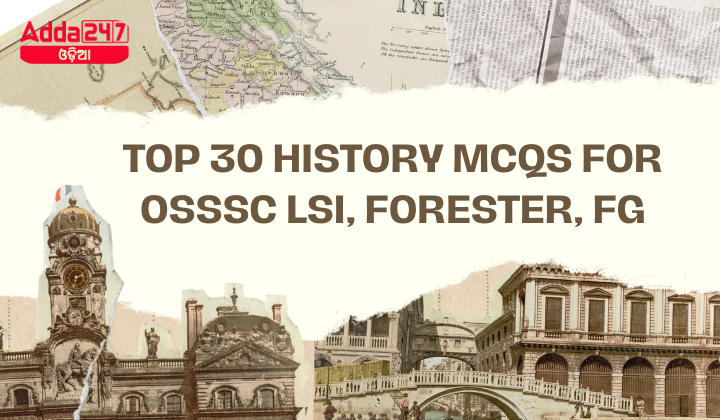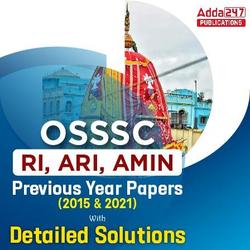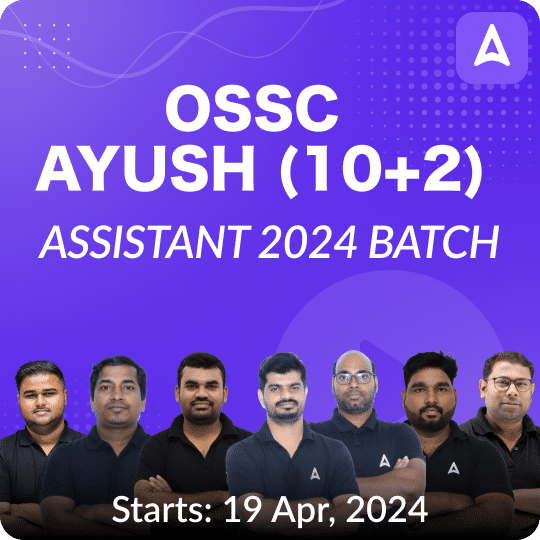History is a vital subject for various competitive exams, including those conducted by the Odisha Sub-Ordinate Staff Selection Commission (OSSSC) for the recruitment of candidates to positions like Livestock Inspector (LSI), Forester, and Forest Guard (FG). Mastering history not only enhances your knowledge but also boosts your chances of performing well in these exams. Here are the top 30 multiple-choice questions (MCQs) covering various periods and themes in history that are relevant for these exams:
- After the revolt of 1857, which of the following changes was not made by the British government?
A) The Secretary of State for India was appointed
B) The number of Indian soldiers was increased in the British Army
C) The rights of the East India Company were handed over to the British Empire
D) The Governor-General of India became the Viceroy of India
Answer: B) The number of Indian soldiers was increased in the British Army - During the 1857 uprising, who among the following took up the leadership at Faizabad?
A) Kunwar Singh
B) Maulvi Ahmadullah
C) Begum Hazrat Mahal
D) Khan Bahadur
Answer: B) Maulvi Ahmadullah - The Sepoy Mutiny of 1857 took place when _____ was the Governor-General of India.
A) Lord Bentinck
B) Lord Wellesley
C) Lord Dalhousie
D) Lord Canning
Answer: D) Lord Canning - Veer Kunwar Singh Jayanti is celebrated in ____ in order to recognize the achievements of Kunwar Singh during the Indian Rebellion of 1857?
A) Himachal Pradesh
B) Bihar
C) Uttarakhand
D) Uttar Pradesh
Answer: B) Bihar - The Sepoy Mutiny in India started from _______?
A) Rajkot
B) Meerut
C) Bareilly
D) Champaran
Answer: B) Meerut - Who among the following was appointed as the first Viceroy of British India?
A) Lord Canning
B) Lord Wavell
C) Lord Irwin
D) Lord Mayo
Answer: A) Lord Canning - Who was the organizer of the revolt of 1857 in Bihar?
A) Bahadur Shah
B) Nana Sahib
C) Maulvi Ahmadullah
D) Kunwar Singh
Answer: D) Kunwar Singh - Who among the following was NOT associated with the revolt of 1857?
A) Kunwar Singh
B) Begum Hazrat Mahal
C) Mangal Pandey
D) Bhagat Singh
Answer: D) Bhagat Singh - Bihar Diwas is celebrated on _________ across the state to commemorate the day when Bihar was carved out of the Bengal Presidency in the year 1912.
A) 21st December
B) 21st January
C) 22nd February
D) 22nd March
Answer: D) 22nd March - Mangal Pandey was hanged in 1857 for attacking the British officers in?
A) Allahabad
B) Benaras
C) Calcutta
D) Barrackpore
Answer: D) Barrackpore - When was the ‘Battle of Tukaroi’ fought?
a) 1532
b) 1565
c) 1575
d) 1546
Answer: c) 1575 - The Battle of Karnal in 1739 was fought between Nadir Shah and whom among the following?
a) Akbar Shah
b) Bahadur Shah Zafar
c) Aurangzeb
d) Muhammad Shah
Answer: d) Muhammad Shah - After which battle did East India Company start appointing the residents in Indian states?
a) Battle of Haldighati
b) Battle of Buxar
c) Battle of Plassey
d) Third Battle of Panipat
Answer: b) Battle of Buxar - The British annexed Punjab after defeating the Sikhs in the Anglo-Sikh War in the year ____?
a) 1835
b) 1839
c) 1849
d) 1845
Answer: c) 1849 - Which king inscribed the Hathigumpha (Elephant Cave) inscription in Udayagiri Hills, Odisha?
a) Galaveya
b) Sobhanaraja
c) Kharavela
d) Vaduka
Answer: b) Sobhanaraja - In which year was the battle of Buxar fought?
a) 1758
b) 1757
c) 1765
d) 1764
Answer: d) 1764 - In the context of medieval Sufi tradition, the term ‘wali’ meant?
a) hermitage
b) order
c) disciple
d) saint
Answer: d) saint - After the battle of _______ in 1757, the British achieved political power in India.?
a) Aliwal
b) Buxar
c) Plassey
d) Saragarhi
Answer: c) Plassey - Srirangapatnam Fort is located in _________?
a) Kerala
b) Karnataka
c) Telangana
d) Tamil Nadu
Answer: b) Karnataka - Who ruled Mysore under the subsidiary alliance with the British after the defeat of Tipu Sultan at the Battle of Seringapatam?
a) Gangas
b) Kadambs
c) Wodeyars
d) Pandyans
Answer: c) Wodeyars - Who among the following was killed by Chatrapati Shivaji in the Battle of Pratapgarh?
A) Afzal Khan
B) Asghar Khan
C) Shaista Khan
D) Shuja Khan
Answer: A) Afzal Khan - Representatives of the Maratha Empire and the British East India Company Signed the ‘Treaty of Salbai’ in which year?
A) 1782
B) 1769
C) 1758
D) 1771
Answer: A) 1782 - In the year __, the Maratha empire ceased to exist with the surrender of the Marathas to the British, ending the third Anglo-Maratha War?
A) 1792
B) 1811
C) 1818
D) 1806
Answer: C) 1818 - Shivaji’s son from Saibai was named _____?
A) Sambhaji
B) Bajirao
C) Shahaji
D) Shahu
Answer: A) Sambhaji - The Battle Of Plassey Was Fought Siraj-ud-daulah And British East India Company On?
A) 23 June 1757
B) 21 June 1780
C) 25 May 1765
D) 15 May 1761
Answer: A) 23 June 1757 - Who signed the treaty of Alinagar with the British?
A) Mir Qasim
B) Siraj-ud-Daula
C) Alivardi Khan
D) Mir Jafar
Answer: B) Siraj-ud-Daula - In which year was the Second Anglo-Mysore war fought between the Kingdom of Mysore and the British East India Company?
A) 1785-1789
B) 1769-1775
C) 1766-1769
D) 1780-1784
Answer: D) 1780-1784 - Chhatrapati Shivaji and Soyarabai named their son _____?
A) Shambhaji
B) Narayan
C) Shahaji
D) Rajaram
Answer: D) Rajaram - The third battle of Panipat was fought between whom?
A) Maratha Empire and Durrani
B) Prithviraj Chauhan and Muhammad Ghori
C) Sikhs and Mughals
D) Akbar and Hemchandra Vikramaditya
Answer: A) Maratha Empire and Durrani - Who wrote the ‘Akbarnama’ and ‘Ain-i-Akbari’?
a) Akbar
b) Ziauddin Barani
c) Abul Fazal
d) Abdul Qadir Badayuni
Answer: c) Abul Fazal
















